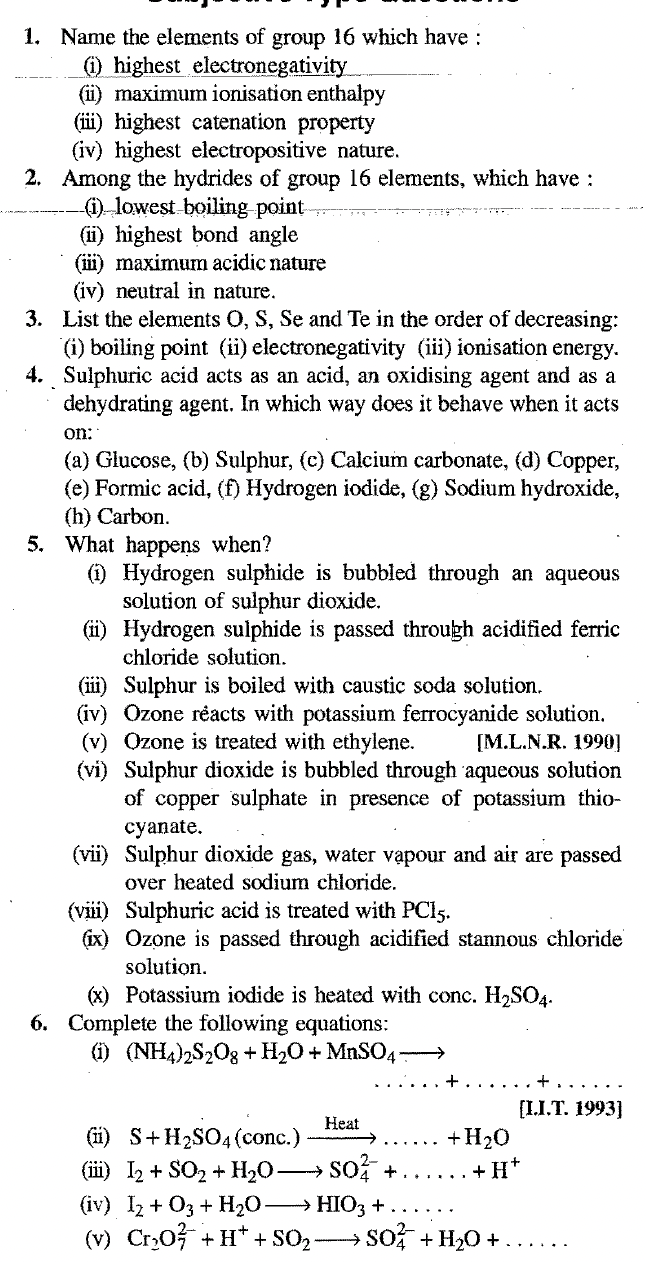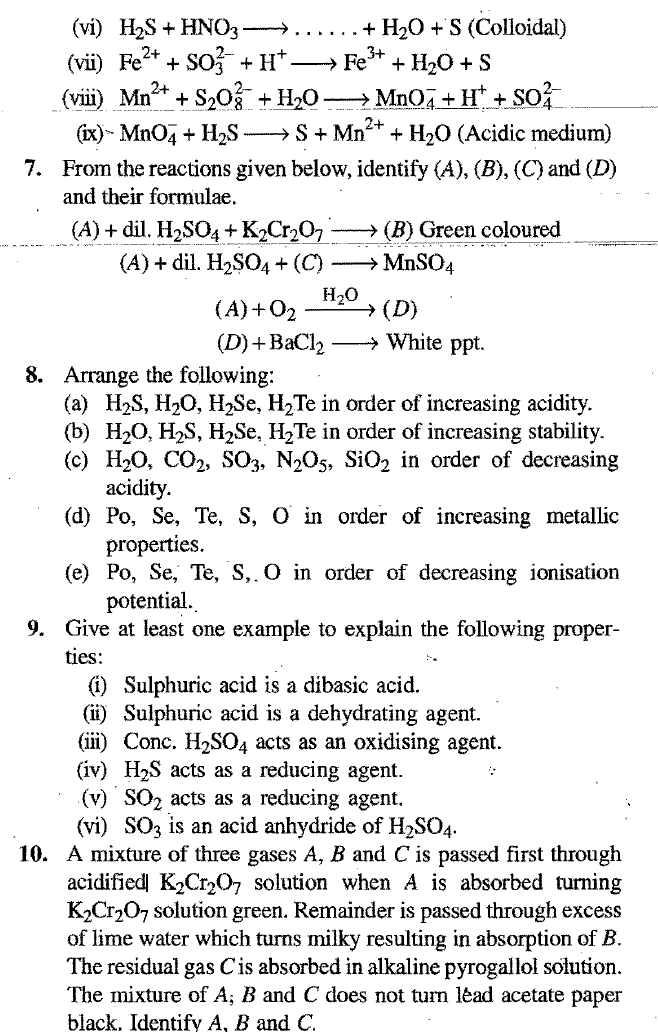Group 16- 5
Answers (1)
1. Group 16 Element Properties:
(i) Highest Electronegativity: Oxygen (O)
(ii) Maximum Ionisation Enthalpy: Oxygen (O)
(iii) Highest Catenation Property: Sulphur(S)
(iv) Highest Electropositive Nature: Polonium (Po)2. Group 16 Hydride Properties:
(i) Lowest Boiling Point: Hydrogen sulfide (H₂S)
(ii) Highest Bond Angle: Water (H₂O) - Around 104.5° due to lone pairs
(iii) Maximum Acidic Nature: Hydrofluoric acid (HF) (not Group 16, but most acidic) - Strong H-F bond
(iv) Neutral in Nature: Methane (CH₄) (Group 14, equal C-H polarities)3. Order of Decreasing Properties:
(i) Boiling Point: Te > Se > S > O
(ii) Electronegativity: O > S > Se > Te
(iii) Ionization Energy: O > S > Se > Te4. Sulfuric Acid Behavior:
(a) Glucose: Dehydrating agent (removes water, forms carbon and water vapor)
(b) Sulfur: Oxidizing agent (depending on concentration/temperature, converts S to SO₂ or SO₃)
(c) Calcium carbonate: Acidic agent (reacts to form CO₂, H₂O, and CaSO₄)
(d) Copper: No reaction (copper is a noble metal)
(e) Formic acid: Acidic agent (H₂SO₄ is a stronger acid)
(f) Hydrogen iodide: Reducing agent (depending on concentration/temperature, H₂SO₄ can oxidize HI to I₂)
(g) Sodium hydroxide: Neutralization (forms Na₂SO₄ and H₂O)
h) Carbon: Dehydrating agent (removes water from hydrates or converts diamond to graphite at high temperatures)5. Reaction Occurrences:
(i) H₂S + SO₂ (aq): Forms elemental sulfur (S) (redox reaction)
(ii) H₂S + FeCl₃ (aq, acidic): Precipitates black iron(III) sulfide (Fe₂S₃)
(iii) S + NaOH (aq): Forms Na₂S and Na₂S₂O₃ (disproportionation)
(iv) O₃ + K₄Fe(CN)₆ (aq): No observable reaction (relatively unreactive with K₄Fe(CN)₆ in this form)
(v) O₃ + C₂H₄: Decomposes ozone, reacts with ethylene (products depend on conditions)
(vi) SO₂ + CuSO₄ (KSCN): Forms CuSCN precipitate (complex formation)
(vii) SO₂ + H₂O + Air + NaCl (hot): No reaction (inert under these conditions)
(viii) H₂SO₄ + PCl₅: Forms POCl₃, SO₂FCl, and HF (phosphoryl chloride)
(ix) O₃ + SnCl₂ (aq, acidic): Reduces Sn⁴⁺ to Sn²⁺ (decomposes ozone)
(x) KI + conc. H₂SO₄: Forms I₂, SO₂, and H₂O (oxidation-reduction)6. Equation Completions:
(i) (NH4)₂S₂O₈ + H₂O + MnSO₄ → Mn(NO₃)₂ + H₂SO₄ + NH₄HSO₄ (ammonium persulfate decomposes)
(ii) S + H₂SO₄ (conc.) → SO₂ + H₂O (oxidation)
(iii) I₂ + SO₂ + H₂O → SO₄²⁻ + 2I⁻ + 2H⁺ (reduction of I₂)
(iv) I₂ + O₃ + H₂O → HIO₃ + I⁻ + O₂ (oxidation of I₂)
(v) Cr₂O₇²⁻ + 2H⁺ + SO₂ → SO₄²⁻ + Cr³⁺ + H₂O (reduction of Cr₂O₇²⁻)
(vi) H₂S + HNO₃ → NO + NO₂ + H₂O + S (colloidal) (oxidation of H₂S and HNO₃)
(vii) Fe²⁺ + SO₃²⁻ + 2H⁺ → Fe³⁺ + SO₂ + H₂O (oxidation of Fe²⁺ to Fe³⁺)
(viii) Mn²⁺ + S₂O₈²⁻ + H₂O → MnO₄⁻ + 2SO₄²⁻ + 2H⁺ (oxidation of Mn2+)
7. Identifying Compounds:- (A): FeSO₄ (ferrous sulfate) - Reducing agent, oxidizes to Fe³⁺ (green solution).
- (B): Cr₂(SO₄)₃ (chromic sulfate) - Reduction product of K₂Cr₂O₇.
- (C): MnO (manganous oxide) - Oxidized by FeSO₄.
- (D): H₂SO₄ (sulfuric acid) - Formed from FeSO₄ and H₂SO₄, reacts with BaCl₂.
8. Ordering Compounds:
(a) Acidity: H₂Se < H₂S < H₂Te < H₂O (O-H bond strength)
(b) Stability: H₂O > H₂S > H₂Se > H₂Te (O-H bond strength)
(c) Acidity (decreasing): N₂O₅ > SO₃ > CO₂ > H₂O > SiO₂ (Non-metal oxide vs. H₂O/SiO₂)
(d) Metallic Properties: Po > Te > Se > S > O (Atomic size and bonding)9. Sulfuric Acid Properties:
(i) Dibasic Acid: Donates 2 H⁺ ions (H₂SO₄ → H⁺ + HSO₄⁻ → H⁺ + SO₄²⁻)
(ii) Dehydrating Agent: Removes water (H₂SO₄ + CaCl₂·2H₂O → CaCl₂ + 2H₂O)
(iii) Oxidizing Agent (conc.): Accepts electrons (H₂SO₄ + Cu → CuSO₄ + SO₂ + H₂O)
(iv) H₂S as Reducing Agent: Donates electrons (H₂S + 2Cl₂ → 2HCl + S)
(v) SO₂ as Reducing Agent: Donates electrons (5SO₂ + 2KMnO₄ + 2H₂O → K₂SO₄ + 2MnSO₄ + 2H₂SO₄)
(vi) SO₃ as Acid Anhydride: Reacts with water to form H₂SO₄ (SO₃ + H₂O → H₂SO₄)10. Identifying Gases:
- A: SO₂ (reducing agent, absorbed by K₂Cr₂O₇)
- B: CO₂ (turns limewater milky)
- C: O₂ (absorbed by alkaline pyrogallol)
- Mixture doesn't contain H₂S (no blackening of lead acetate paper).



